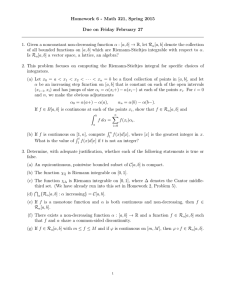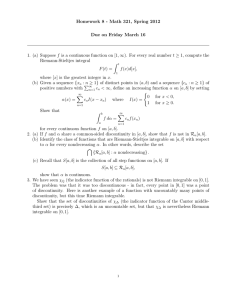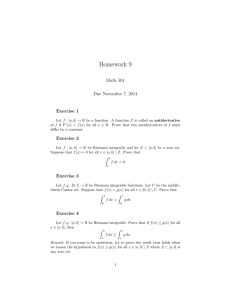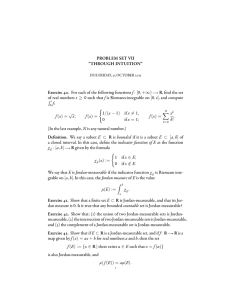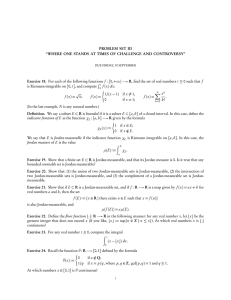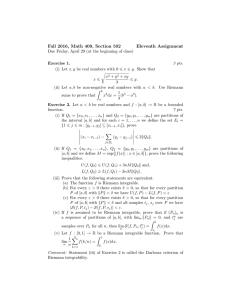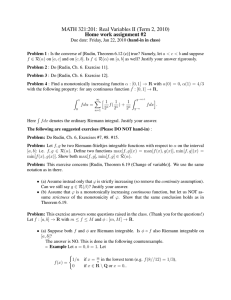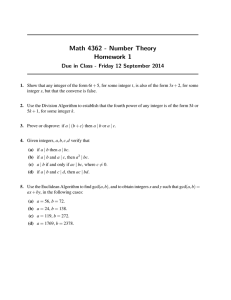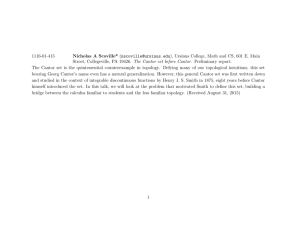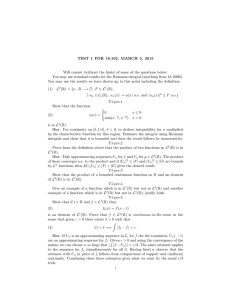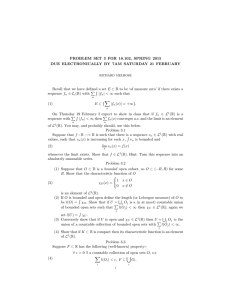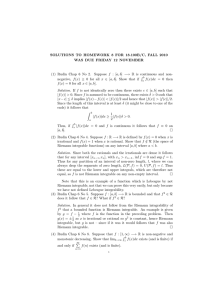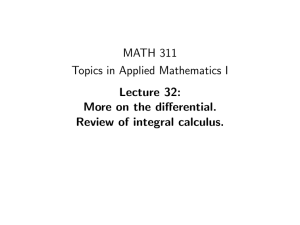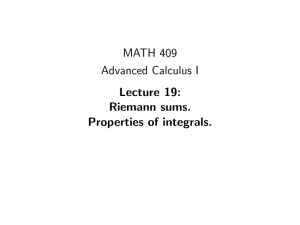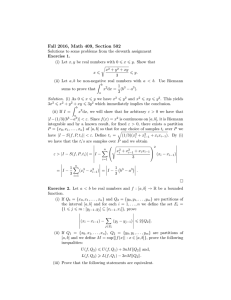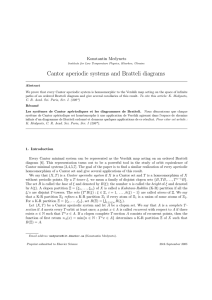PROBLEM SET II “HIC SUNT DRACONES.”
advertisement
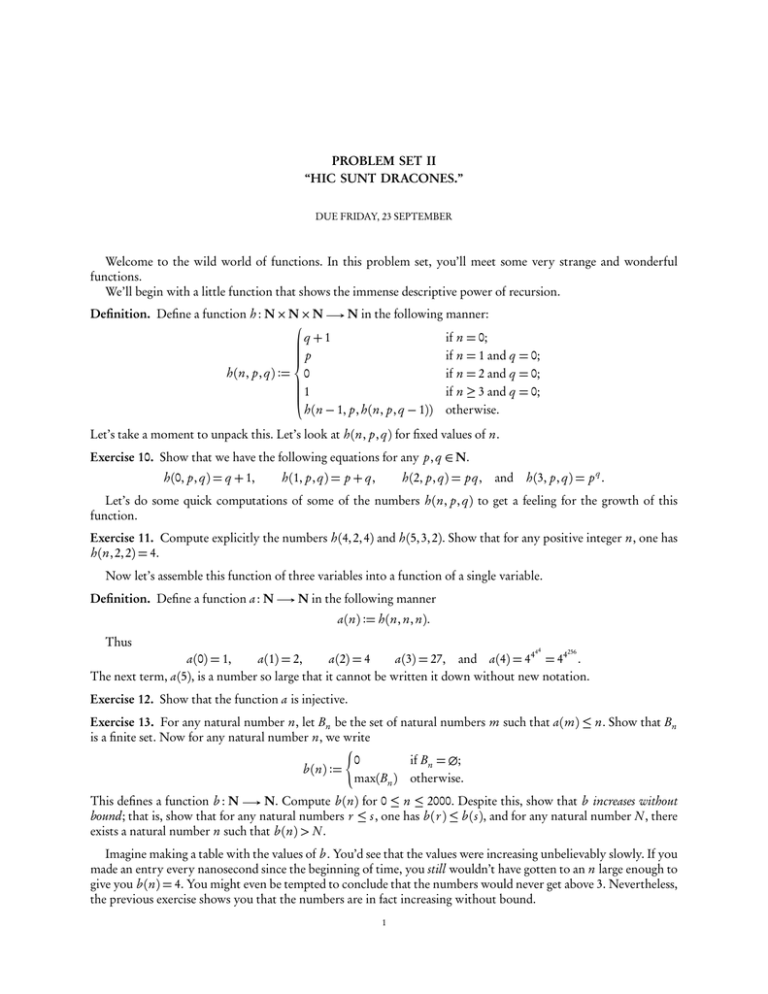
PROBLEM SET II
“HIC SUNT DRACONES.”
DUE FRIDAY, 23 SEPTEMBER
Welcome to the wild world of functions. In this problem set, you’ll meet some very strange and wonderful
functions.
We’ll begin with a little function that shows the immense descriptive power of recursion.
N in the following manner:
Definition. Define a function h : N × N × N
if n = 0;
q + 1
p
if n = 1 and q = 0;
h(n, p, q) := 0
if n = 2 and q = 0;
1
if
n ≥ 3 and q = 0;
h(n − 1, p, h(n, p, q − 1)) otherwise.
Let’s take a moment to unpack this. Let’s look at h(n, p, q) for fixed values of n.
Exercise 10. Show that we have the following equations for any p, q ∈ N.
h(0, p, q) = q + 1,
h(1, p, q) = p + q,
h(2, p, q) = p q,
and
h(3, p, q) = p q .
Let’s do some quick computations of some of the numbers h(n, p, q) to get a feeling for the growth of this
function.
Exercise 11. Compute explicitly the numbers h(4, 2, 4) and h(5, 3, 2). Show that for any positive integer n, one has
h(n, 2, 2) = 4.
Now let’s assemble this function of three variables into a function of a single variable.
Definition. Define a function a : N
N in the following manner
a(n) := h(n, n, n).
Thus
44
256
a(0) = 1,
a(1) = 2,
a(2) = 4
a(3) = 27, and a(4) = 44 = 44 .
The next term, a(5), is a number so large that it cannot be written it down without new notation.
Exercise 12. Show that the function a is injective.
Exercise 13. For any natural number n, let Bn be the set of natural numbers m such that a(m) ≤ n. Show that Bn
is a finite set. Now for any natural number n, we write
(
0
if Bn = ∅;
b (n) :=
max(Bn ) otherwise.
N. Compute b (n) for 0 ≤ n ≤ 2000. Despite this, show that b increases without
This defines a function b : N
bound; that is, show that for any natural numbers r ≤ s, one has b (r ) ≤ b (s), and for any natural number N , there
exists a natural number n such that b (n) > N .
Imagine making a table with the values of b . You’d see that the values were increasing unbelievably slowly. If you
made an entry every nanosecond since the beginning of time, you still wouldn’t have gotten to an n large enough to
give you b (n) = 4. You might even be tempted to conclude that the numbers would never get above 3. Nevertheless,
the previous exercise shows you that the numbers are in fact increasing without bound.
1
2
DUE FRIDAY, 23 SEPTEMBER
Definition. The Cantor set C ⊂ R is defined in the following manner. Set C0 := [0, 1]. Proceed iteratively in the
following manner. For every natural number n > 0, set
3n−1
[−1 3k + 1 3k + 2
M n :=
,
and
Cn := Cn−1 − M n .
3n
3n
k=0
Finally, set
C :=
\
Cn .
n∈N
{0, 1}, where N+ = {n ∈ N | n ≥ 1}. Let us define a
Now let Map(N+ , {0, 1}) denote the set of all maps N+
map f : C
Map(N+ , {0, 1}).
We define, recursively, a map fn : Cn
Map({1, 2, . . . , n}, {0, 1}) for every n ∈ N. For n = 0, there’s nothing to
do, since there is only one map ∅
{0, 1}. Now suppose the map fn−1 is defined; then set, for any point x ∈ Cn
and any integer 1 ≤ m ≤ n,
f (x)(m) if 1 ≤ m ≤ n − 1;
n−1
3k+1
0
if m = n and if for some integer k, x ∈ 3k
;
n ,
n
:=
fn (x)(m)
3
3
h
i
3k+2 3(k+1)
1
if m = n and if for some integer k, x ∈ 3n , 3n
;
Map({1, 2, . . . , n}, {0, 1}). Now we define the map fn : C
this defines our map fn : Cn
formula f (x)(m) := fn (x)(m) for any integer n ≥ m.
Exercise 14. Show that the function f : C
Map(N+ , {0, 1}) by the
Map(N+ , {0, 1}) is a bijection.
The so-called indicator function of the Cantor set is Riemann-integrable:
Exercise 15. Show that the function f : [0, 1]
is Riemann integrable. What is the integral
R1
0
[0, 1] defined by the formula
(
0 if x ∈
/ C;
f (x) :=
1 if x ∈ C
f (x) dx?
The rational numbers may seem like a tamer set than the Cantor set, but the indicator function of Q is not
Riemann-integrable:
Exercise 16. Show that the function d : R
[0, 1] defined by the formula
(
0 if x ∈
/ Q;
d (x) :=
1 if x ∈ Q
is not Riemann integrable on [0, 1].
Strangely, the even crazier-seeming popcorn function is Riemann-integrable:
Exercise 17. Show that the function θ: R
[0, 1] defined by the formula
(
0
if x ∈
/ Q;
θ(x) :=
1/q if x = p/q, where p, q ∈ Z, gcd( p, q) = 1 and q ≥ 1.
R1
is Riemann integrable on [0, 1]. What is the integral 0 θ(x) dx?
